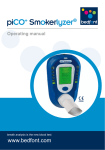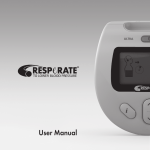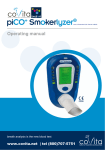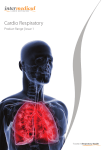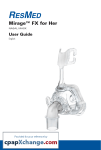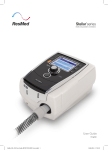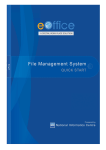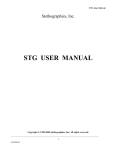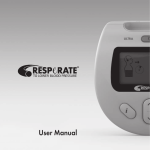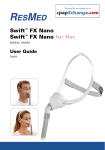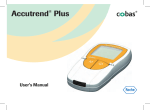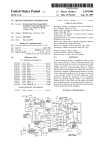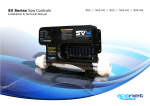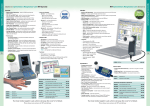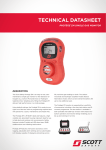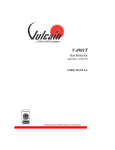Download piCO S oker m lyzer® piCO S oker m lyzer
Transcript
® + piCO Smokerlyzer ® + piCO Smokerlyzer Breath Carbon Monoxide (CO) Monitor User Manual Bedfont Scientific, USA Tel: (609) 654-5561 Fax: (609) 654-9878 Email: [email protected] www.bedfontusa.com scientific contributions to health Part No.: LAB220 scientific contributions to health Contents i ENGLISH Introduction and Intended Use..................... 1 Quick Start Guide......................................... 2 Pack Contents & Specification..................... 3 Instrument Layout........................................ 4 Display Symbols.......................................... 5 Warnings & Maintenance............................. 6 Operation..................................................... 7 Calibration.................................................... 10 Set-Up - User Profiles ................................. 12 Set-Up - Sounder Operation........................ 13 Troubleshooting............................................ 14 COdata+ Software.......................................... 15 Returns Procedure....................................... 16 Spares & Warranty....................................... 17 Frequently Asked Questions........................ 18 piCO+Smokerlyzer ® 1 Introduction and Intended Use The piCO+ Smokerlyzer® is a Breath Carbon Monoxide Monitor intended for multipatient use by healthcare professionals in smoking cessation programmes, research and as an indicator of Carbon Monoxide poisoning. Carbon Monoxide is a toxic, odourless, colourless, tasteless gas. It is formed from incomplete combustion of organic material at high temperatures with an insufficient Oxygen supply. When inhaled, CO competes successfully with Oxygen in the bloodstream to form Carboxyhaemoglobin (COHb). This starves the body tissues of the Oxygen vital to repair, regeneration and general living. CO can remain in the bloodstream for up to 24 hours, depending on a range of factors including physical activity, gender and inhalation intensity. The half life is about 5 hours. CO (ppm)/Carboxyhaemoglobin (%COHb) Correlation: Breath Carbon Monoxide is measured in parts per million (ppm CO) and blood Carboxyhaemoglobin in percentages (%COHb). The two are compatible and convertible, CO relating to lung/breath and COHb to blood gas - the piCO+ Smokerlyzer® displays both measurements. Clinical research has demonstrated that a useful relationship between Carbon Monoxide and Carboxyhaemoglobin is obtained after a short period of breathholding by the person. CO readings demonstrate the levels of poisonous inhaled CO while the COHb reading shows the percentage of vital Oxygen that has been replaced in the bloodstream. The cut off point between smoker and non-smoker has been found to be 6ppm CO. The piCO+ Smokerlyzer® shows a non-smoker to be 0-6ppm, a low dependence smoker to be 7-15ppm and strongly addicted smokers to be over 15ppm. The piCO+ Smokerlyzer® has been designed so that it can also be used with young smokers. As their smoking habits and views are generally different from adult smokers, the display has been changed. 0-4ppm shows a non-smoker, 5-6ppm a light or casual smoker and 7ppm+ a more frequent young smoker. Other cut-off points can be adopted as well as smoker classification at higher CO levels. The piCO+ has a third programme which can be set by the user with COdata+ software to achieve complete flexibility in most circumstances. User Manual Issue 2 - 08/06 Quick Start Guide 2 ENGLISH 1. Turn on monitor by holding button for 3 seconds. 2. Attach breath sampling D-piece and a new mouthpiece. 3. Inhale and double click button to start breath test. 4. Hold breath for 15 second countdown. If unable to hold breath for full 15 seconds, see Operation section on page 7. 5. The audio bleep will sound during the last three seconds of the countdown. 6. Blow slowly into mouthpiece, aiming to empty lungs completely. 7. The ppm and equivalent % Carboxyhaemoglobin (COHb) levels will rise and hold. The coloured LEDs will light accordingly. See table on page 8 for an interpretation of reading. 9.2 8. Remove D-piece between tests to purge sensor with fresh air. Remove D-piece by pressing securing lug with a fingernail in the exhaust port and pulling out from the front. 9. To repeat breath test, double click button to return to main display and continue from step 2 above. 10. To switch off, hold button for 3 seconds. Unit will auto power off after 5 minutes of inactivity. piCO+Smokerlyzer ® 3 Pack Contents & Specification Pack Contents List Key: 1. Instrument 2. Carry pouch 3. User Manual 4. Breath sampling D-piece 5. Disposable cardboard mouthpiece 6. 2 x AA batteries 2 3 5 1 6 4 Specification Concentration Range: Display: Detection Principle: Accuracy (repeatability of readings): H2 Cross Interference: Power: Response Time: Operating Temperature Range: Operating Humidity: Sensor Operating Life: Sensor Sensitivity: Dimensions: Weight: Monitor Construction: 0086 User Manual Issue 2 - 08/06 0 - 80ppm (higher using COdata+ software) LCD with 1ppm increments Electrochemical sensor +/- 2% < 10% 2 x AA (LR6 or equivalent) alkaline batteries Typically < 45 seconds to 90% FSD 0 - 40oC (Storage 0 - 50oC) 10 - 90% (Storage 0 - 95%) non-condensing Approx. 5 years, 2 year warranty 1 ppm Approx. 45 x 75 x 120 mm Approx. 200g including batteries Body - Polycarbonate/ABS blend with elastomeric overmould. D-piece - Polypropylene Instrument Layout 4 ENGLISH Overview Key: 1. Display 2. Coloured LEDs 3. Button 4. Aperture for D-piece 5. Breath sampling D-piece 6. Securing lug on D-piece 7. Exhaust port for breath sample 8. Sounder aperture 9. USB connector 10. Cardboard mouthpiece 11. Battery Compartment 9 Rear View 11 10 8 0086 008 6 Bedfont Scientific Ltd ME1 3QX, England T: +44 8700 844 050 F: +44 8700 844 051 E: [email protected] www.bedfont.com 3V 2006 2 x AA/LR6 2 2 7 1 5 3 4 6 piCO+Smokerlyzer ® 5 Display Symbols 1. Start up screens: 2. Battery condition - OK: 3. User profile - Adult: 4. Sounder - On: 5. Pointer: 6. Start breath test: 7. Enter Calibration mode: 8. Enter Set-up mode: 9. Inhale: 10. Breath-hold and countdown: 11. Exhale for breath test: 12. Peak CO reading (ppm and %COHb): 13. Set instrument zero in fresh air: 14. Apply calibration gas at 20ppm: 15. Calibration pass/fail - Pass: 16. User profile selection: 17. Select adult user profile: 18. Select adolescent user profile: 19. Select custom user profile (if set via COdata+ software on PC): 20. Contact Bedfont or distributor for help 21. Return: Flat: Dead: Adolescent: Custom: Mute: User Manual Issue 2 - 08/06 9.2 Fail: Warnings & Maintenance 6 ENGLISH People with lung disease or chest ailments may not be able to achieve the 15 second breath-hold. In such cases, the user should inhale and hold their breath when the breath test is started, and exhale, if necessary, before the countdown has completed. Mouthpieces should be replaced after every use. Hands should be washed regularly in accordance with infection control practice. Routine Maintenance Calibrate the monitor using Bedfont 20ppm CO in air calibration gas at least every 6 months (see Page 10). Once calibration has been carried out, the date should be recorded and the next calibration date diarised. Replace batteries when indicated - battery symbol either or . Replace breath sampling D-piece every month or if visibly soiled or contaminated. It cannot be cleaned or sterilised. Record every time this is done and diarise the replacement date. The D-piece is simply removed by pressing the securing lug with a thumbnail or fingernail in the exhaust port and gently pulling out the D-piece from the front. Cleaning Wipe the instrument and D-piece external surfaces with a product specifically developed for this purpose. Bedfont provides an ‘Instrument Cleansing Wipe' (Part No.: WIPE-V) NEVER use alcohol or cleaning agents containing alcohol or other organic solvents as long term exposure to these vapours will damage the CO sensor inside. Under no circumstances should the instrument be immersed in liquid or splashed with liquid. Batteries Batteries should be removed if the instrument is not likely to be used for some time. Additional technical information can be made available on request; please contact Bedfont or its distributor. piCO+Smokerlyzer ® 7 Operation Ensure 2 AA batteries are correctly located in battery compartment. The single button controls all functions: - One long button press (>3 seconds) turns the unit on. - A single click scrolls the pointer through the list of options. - A quick double click selects the required option. - One long button press (>3 seconds) turns the unit off. Press and hold the button for 3 seconds until the display becomes active. Release the button. After a 10 second warm-up period during which a start-up screen is displayed, the main menu will appear. If a is shown rather than the main menu, the instrument has failed to set a fresh air zero during start-up, perhaps because the ambient air was not clear of Carbon Monoxide. Ensure that the instrument is in fresh air and then double click the button to repeat the start-up test. If it fails again, please read the Troubleshooting section on page 14. With the pointer opposite the picture of an exhaling face, the piCO+ is ready to start a breath test. The green LEDs will double flash to indicate that the instrument is ready. Attach a breath sampling D-piece and a new cardboard mouthpiece to the piCO+. Check all connections are pushed firmly together. To start a breath test, the patient should inhale and hold their breath, then a quick double click of the button will initiate a 15 second countdown display. User Manual Issue 2 - 08/06 Operation continued 8 ENGLISH Ensure that the breath is held throughout the countdown. The audio bleep will sound during the last 3 seconds of the countdown. Once the countdown reaches zero, exhale slowly but gently into the mouthpiece. Aim to empty the lungs as far as possible. If the patient cannot hold their breath for the full 15 seconds, they should commence exhalation at a comfortable point, but exhale completely. The display will show a rising ppm value, and an equivalent %COHb reading. The coloured LEDs will light according to the selected user profile: LED Colour Description Green Yellow 1 Red 2 Reds 3 Reds 4 Reds 4 Reds flashing Non-smoker Danger zone Smoker Frequent Smoker Addicted Smoker Heavily Addicted Smoker Dangerously Addicted Smoker Adult (ppm) 0-6 7 - 10 11 - 15 16 - 25 26 - 35 36 - 50 51+ Adolescent (ppm) 0-4 5-6 7 - 10 11 - 15 16 - 25 26 - 35 36+ The sounder will emit bleeps at an increasing frequency according to the concentration of CO measured. To temporarily mute the sounder, single click the button. The highest level seen during the breath exhalation will be held on the display. The test is complete when the pointer and “return” symbols appear at the bottom of the display. 9.2 At this point, a single click of the button will temporarily silence the sounder, if it is on. To start another breath test, double click the button to return to the main display. A new mouthpiece should be used with every test. piCO+Smokerlyzer ® 9 Operation continued Removing the D-piece between tests will allow fresh air to purge the sensor. The Dpiece is simply removed by pressing the securing lug with a thumbnail or fingernail in the exhaust port and gently pulling out the D-piece from the front. It is good practice to wash hands after removing D-piece. If no further tests are required, the piCO+ should be turned off by holding the button for 3 seconds. If left on, the piCO+ will automatically turn off after 5 minutes of inactivity. To re-calibrate the instrument, follow the instructions on Page 10. To change the user profile from adult to adolescent (or a custom profile if one has been set using the COdata+ user software), see the instructions on Page 12. To permanently silence the sounder during the breath-test, follow the instructions on Page 13. User Manual Issue 2 - 08/06 Calibration 10 ENGLISH 1 1.5 l/m 2 1 3 1.0 l/m 0.5 l/m 2 Bedfont Calibration Kit 1. Fine Control Valve 2. Flow Indicator 3. Gas cylinder, 20ppm CO in Air 4. Calibration Adaptor & Tube 4 Instruments are calibrated before leaving Bedfont. The piCO+ should be calibrated at least every 6 months. The calibration gas required is Bedfont 20ppm Carbon Monoxide in air. Ensure the Fine Control Valve is in the off position. Screw the Fine Control Valve and Flow Indicator assembly to the gas can. This is best done by screwing the gas can into the valve. Turn the instrument on in the normal way; when the main menu appears, scroll the pointer down to the symbol of the gas cylinder by a single click of the button, then double-click to select that symbol. Ensure that the instrument is surrounded by fresh air. With the pointer now opposite the “zeroing” symbol, double click the button to set the instrument to zero. If the zeroing has been successful, a tick will be displayed. If the zeroing fails, an will be displayed (see the Troubleshooting section on page 14 if this happens). Double-click the button to return to the calibration menu opposite. piCO+Smokerlyzer ® 11 Calibration continued Single-click the button to scroll the pointer down to the 20ppm gas cylinder symbol, and double click to select that symbol. Immediately open the fine control valve and allow the gas to flow at 0.5 litres per minute. To maintain this, adjust the flow so the ball in the Flow Indicator remains at the lower line. Allow the gas to flow through the instrument for about 1.5 minutes to ensure accurate calibration, again monitoring the rate of flow. As the 20ppm CO calibration gas is applied, the displayed ppm reading will climb. After 1.5 minutes, or until no further increase in the reading is obtained, the final measured value will be shown and sampling will cease. If the displayed reading is between 15 and 25ppm, the calibration value will be automatically set in the instrument as 20ppm and a tick will be displayed to show a successful calibration. If the displayed reading is outside these limits, the calibration fails, and an will be displayed (See the Troubleshooting section on page 14 if this happens). The pointer and “return” symbol re-appear at the bottom of the display to indicate that the process is complete and to allow the user to double click the button to return to the previous menu page. Turn off the gas flow, remove the D-piece sampling system and disconnect the Calibration Adapter from the D-piece sampling system. The D-piece is simply removed by pressing the securing lug with a thumbnail or fingernail in the exhaust port and gently pulling out the D-piece from the front. Unscrew the Fine Control Valve and Flow Indicator from the gas can and store safely. If the valve is left attached to the can, the gas could escape. The piCO+ is now calibrated and ready for use. User Manual Issue 2 - 08/06 Set-Up - User Profiles 12 ENGLISH In the set-up mode, the user can change the selected User Profile from adult to adolescent (or to a third custom profile if one has been set). The User Profiles determine which coloured LEDs are lit during a breath test. The default values for adults and adolescents are shown in the table in the Operation section on Page 8. The currently selected user profile is indicated by the small symbol on the top line of the display - Adult , Adolescent or Custom . To change the selected profile, scroll the pointer to the set-up symbol ( ) on the main display using single clicks of the button. Then double click to select the set-up mode. Scroll the pointer until it is opposite the User Profile selection symbol ( double click to select this function. ), then Scroll the pointer until it is opposite the desired profile, then double click to select. The symbol on the top line of the display will change to show the selected profile. The custom profile ( ) will only be available on the display if it has been previously set using the COdata+ software on a PC. Exit this function by pointing at the “return” symbol and double clicking. This returns you to the previous page of the menu. piCO+Smokerlyzer ® 13 Set-Up - Sounder Operation The set-up mode allows the sounder to be turned off during the breath test, although it will still operate during the breath-hold countdown. The operation of the sounder during the exhalation phase of a breath-test is indicated by the small symbol ( )on the top line of the display. To turn the sounder settings on or off, scroll the pointer to the set-up symbol ( ) on the main display using single clicks of the button. Then double click to select the setup mode - see previous page. Scroll the pointer until it is opposite the sounder symbol ( ), then double click to change from sounder-on ( ) to sounder-off ( ) or back again. The large sounder symbol and the small symbol on the top line of the display will change to show whether the sounder is on or off. Even if the sounder has been turned off, it will continue to operate during the last 3 seconds of the breath-hold countdown. Exit this function by pointing at the “return” symbol ( returns you to the previous page of the menu. ) and double clicking. This If the sounder is left on but needs to be temporarily silenced during or just after the breath-test, this can be achieved by a single click of the button. User Manual Issue 2 - 08/06 Troubleshooting 14 ENGLISH If the unit fails to turn on properly, or if the low battery symbol ( ) is showing, replace the 2 x AA batteries. Ensure that the batteries are inserted the correct way round, matching the symbols moulded into the plastic. If a breath test on a non-smoker gives an indication of CO being present, this may be because of a high ambient level of CO (possibly due to a faulty combustion appliance or exhaust fumes), or due to the effects of passive smoking. A false reading can under certain circumstances be obtained from alcohol on a person's breath, or from the presence of hydrogen, which can be generated in the human digestive system. If the display shows after zeroing, a second attempt can be made to zero the unit in fresh air. Check that the unit is in fresh air and double click the button to restart the zero process. If, after a third zeroing attempt, the display shows again, the unit will have to be returned to Bedfont or its distributor for investigation and repair. In this case, the display shows a telephone and envelope symbol. The unit can be turned off by pressing the button for three seconds. It is possible to re-start the unit and attempt the zeroing process again. If, after an attempted calibration with 20ppm CO gas, the display shows an , the gas value was not within the permitted limits. The achieved reading is displayed underneath the . If this value is much lower than 20ppm, there may have been a problem with the supply of gas from the cylinder during the calibration process. If the displayed value is much higher than 20ppm, it is possible that the wrong concentration of calibration gas is being used. In either case, check the cylinder, connections and flow-rate before double clicking the button to repeat the gas calibration process. If, after a third repeated attempt to calibrate the instrument, the display shows again, the unit will have to be returned to Bedfont or its distributor for investigation and repair. In this case, the display shows a telephone and envelope symbol. The unit can be turned off by pressing the button for three seconds. It is possible to re-start the unit and use it with the previous calibration settings, or attempt the complete calibration process again. piCO+Smokerlyzer ® 15 COdata+ Software Connecting to the PC Place one end of the connection lead into the mini USB socket on the top of the piCO+. Connect the other end to the USB port on the PC. If using a PC serial port, plug the USB/Serial port converter cable into a free serial port. When the software is installed, set the communication port to the one the piCO+ is connected to. Before starting the software, ensure the piCO+ is connected to the PC and switched on. Once the sensor has stabilised, double click the COdata+ icon on the PC to start the programme. Refer to the supplied documentation for how to operate the COdata+ software. The calibration function can only be accessed from the piCO+. The custom user profile can only be accessed from COdata+. User Manual Issue 2 - 08/06 Returns Procedure 16 ENGLISH Should your equipment require servicing, please contact Bedfont's Customer Service Specialist before returning any goods. If you did not purchase direct from Bedfont, please contact your local distributor or supplier. When you have supplied the Customer Service Specialist with the monitor serial number and description of the fault, you will be issued with a Returns Number. Please state this number on a compliment slip or headed paper when returning the monitor, ensuring your full details including telephone and fax numbers are clearly stated. Bedfont advise that you use a courier service when returning monitors, as this enables you to insure goods against loss or damage in transit. When your goods are received you will be sent an Order Acknowledgement. The monitor will then be examined and you will be sent an Engineer's Report and a quotation for the repair which includes an Authorisation Form. If your monitor is still in warranty, Bedfont will repair it and return it to you with an Engineer's Report, free of charge. If the monitor is found to simply require calibrating, you will be charged a fee for this service if you wish to proceed. If outside warranty and you wish to proceed with the repair or calibration, complete the Authorisation Form within the quotation, ensuring you include an Official Purchase Order Number, and return to Bedfont. (Contact the Customer Support Specialist if you are unable to supply an Official Purchase Order Number.) If you choose not to proceed with the repair, a handling fee will be charged. Ensure you return the completed Authorisation Form with an Official Purchase Order Number. The equipment will be returned to you as soon as Bedfont have received all the relevant paper work. A carriage fee will be charged if the monitor is no longer in warranty. piCO+Smokerlyzer ® 17 Spares & Warranty Warranty Bedfont Scientific Limited warrants the piCO+ (excluding batteries) to be free of defects in materials and workmanship for a period of two years from the date of shipment. Bedfont's sole obligation under this warranty is limited to repairing or replacing, at its choice, any item covered under this warranty when such an item is returned intact, prepaid, to Bedfont Scientific Limited or the local representative. These warranties are automatically invalidated if the products are repaired, altered or otherwise tampered with by unauthorised personnel, or have been subject to misuse, neglect or accident. At the end of the product's life, do not dispose of any electronic instrument in the domestic waste, but contact Bedfont or its distributor for disposal instructions. Bedfont Scientific, USA 22 Coates Street, Suite 1 Medford, NJ 08055 Tel: (609) 654-5561 Fax: (609) 654-9878 Email: [email protected] www.bedfontusa.com User Manual Issue 2 - 08/06 Frequently Asked Questions (FAQ) 18 ENGLISH Frequently Asked Questions about breath Carbon Monoxide (CO) monitoring in smoking cessation Q. What is Carbon Monoxide? A. Carbon Monoxide (CO) is a poisonous gas that you cannot smell or see. When a smoker inhales smoke from a cigarette, CO is absorbed into their blood through their lungs. CO is dangerous because it binds to haemoglobin in red blood cells about 200 times as readily as oxygen, depriving the body of the vital oxygen it needs to live. Q. What does a breath CO test show? A. It shows the amount of Carbon Monoxide in a smoker's breath (ppm CO), which is a measure of blood Carboxyhaemoglobin (%COHb). It acts as an indicator as to the possible level of some 4,000 toxic substances in cigarette smoke, 60 of which cause cancer. Q. What does ppm and COHb mean? A. Parts per million. In this case, one part CO in one million parts of air (breath). This might not seem like very much, but ppm has a direct correlation with %COHb the percentage of CO combined with haemoglobin in a smoker's blood. If your patient gives a reading of 20ppm, that of a frequent adult smoker, it means that their oxygen carrying capacity is reduced by 5%. It also indicates a high level of addiction to nicotine. Q. How quickly does the CO disappear from the body after smoking stops? A. It takes about 5-6 hours to reduce the original level by half. Usually after a maximum period of 48 hours the ex-smoker will show the level of a non-smoker living in the same environment. Q. How long after a cigarette should the test be conducted? A. After a minimum of 10 minutes. Q. What levels of breath CO do you expect to see? A. Clinical research has shown that the popular guidelines are: 0-6ppm: non-smoker 7-10ppm: danger zone (possible low-frequency smoking) 11-15ppm: smoker 16-25ppm: frequent smoker 26-35ppm: addicted smoker 36-50ppm: heavily addicted smoker 51+ppm: dangerously addicted smoker piCO+Smokerlyzer ® 19 FAQ Continued Q. If a smoker cuts down, will this reduce breath CO by an equivalent amount? A. Probably not. A smoker may smoke fewer cigarettes, but will require the same amount of nicotine. Therefore they may smoke a smaller number, but will smoke more aggressively and inhale more smoke - and CO - than expected. However, this effect can be offset by the use of nicotine replacement therapy (NRT) which reduces a person's craving for nicotine and how much smoke they inhale. Q. Is it necessary to hold the breath before taking the test? A. Not absolutely necessary. Clinical research has shown that an optimum period of 15 seconds breath hold is required to get the best correlation with COHb. Less than this will depress the breath CO reading. However, as long as the person is encouraged to exhale completely, an ‘end-tidal' breath sample will give a good enough indication. Q. Do cigars and pipes give low readings? A. No, on the contrary: an inhaled puff of pipe or cigar smoke is much more concentrated and will give surprisingly high COHb readings. Marijuana smoking, especially when mixed with tobacco, will also elevate blood CO. Q. Why do non-smokers sometimes give higher than expected readings? A. This could be for several reasons: They have been exposed to high ambient levels of CO. For example, at home or in the car. It could be useful to check other family members in order to eliminate possible chronic CO poisoning. Certain occupations may expose workers to high CO levels. For example, a degreasing agent called trichloroethylene is metabolised by the liver to produce COHb. Some CO monitors may have a cross interference from other breath constituents. The most likely ones are alcohol and hydrogen. The latter may be present due to a gut condition called lactose intolerance - an allergy to dairy products that produces hydrogen gas in the intestine. Some of this gas may be excreted via the lungs. Smokerlyzers® contain filters that prevent alcohol and other organic species (including acetone from the breath of diabetics) influencing the CO results. Q. How hygienic is the test? A. A disposable mouthpiece is used for each person taking the test. They are designed to be single-use only. These mouthpieces usually fit into a device connected to the CO monitor itself. With Smokerlyzers®, these sampling systems contain one-way valves which stop people sucking air back from the monitors. Q. How fast is the test? A. A test takes only a few seconds. You may want to allow for a couple of minutes to include instruction, breath hold, and a confirmatory test if necessary. User Manual Issue 2 - 08/06






















